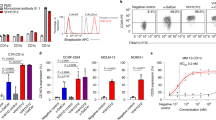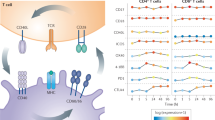Abstract
We investigated the effect of Fas/APO1-ligand (CD95L) gene transfer on allogeneic immune responses in vivo. A colon carcinoma cell line from BALB/c mice, CT26, was stably transfected with a vector encoding mouse CD95L and was inoculated into C57BL/6 mice. CD95L expression markedly reduced allogeneic cytotoxic T lymphocyte and helper T lymphocyte activity directed toward CT26. Strikingly, expression of CD95L on these allogeneic tumors completely inhibited the generation of alloantibodies of both IgM and IgG subclasses. Thus, CD95L inhibited alloantibody production and conferred localized immune suppression through this mechanism. These results provide insight into the role of CD95L in regulating the alloantibody response and the generation of local immune responses.
This is a preview of subscription content, access via your institution
Access options
Subscribe to this journal
Receive 12 print issues and online access
$209.00 per year
only $17.42 per issue
Buy this article
- Purchase on Springer Link
- Instant access to full article PDF
Prices may be subject to local taxes which are calculated during checkout
Similar content being viewed by others
References
Matzinger, P. & Bevan, M.J. Why do so many lymphocytes respond to major histocompatibility antigens? Cell. Immunol. 29, 1–5 (1977).
Sayegh, M.H., Watschinger, B. & Carpenter, C.B. Mechanisms of T cell recognition of alloantigen: The role of peptides. Transplantation 57, 1295–1302 (1994).
Bradley, J.A., Mowat, A.M. & Bolton, E.M. Processed MHC class I alloantigen as the stimulus for CD4+ T-cell dependent antibody-mediated graft rejection. Immunol. Today 13, 434–438 (1992).
Bishop, D.K., DeBruyne, L.A., Chan, S., Xu, S. & Eichwald, E.J. Dissociation of mouse cardiac transplant rejection and donor alloantigen-specific T cell responsive-ness. Transplant. Immunol. 3, 222–228 (1995).
Itoh, N. et al. The polypeptide encoded by the cDNA for human cell surface antigen Fas can mediate apoptosis. Cell 66, 233–243 (1991).
Suda, T., Takahashi, T., Golstein, P. & Nagata, S. Molecular cloning and expression of the Fas ligand, a novel member of the tumor necrosis factor family. Cell 75, 1169–1178 (1993).
Nagata, S. & Golstein, P. The Fas death factor. Science 267, 1449–1456 (1995).
Lynch, D.H., Ramsdell, F. & Alderson, M.R. Fas and FasL in the homeostatic regulation of immune responses. Immunol. Today 16, 569–574 (1995).
Dhein, J., Walczak, H., Baumler, C., Debatin, K. & Krammer, P.H. T-cell suicide mediated by APO-1 /(Fas/CD95). Nature 373, 438–441 (1995).
Chan, S.Y., DeBruyne, L.A., Goodman, R.E., Eichwald, E.J. & Bishop, D.K. In vivo depletion of CD8+ T cells results in Th2 cytokine production and alternate mechanisms of allograft rejection, Transplantation 59, 1155–1161 (1995).
Brunner, T. et al. Cell-autonomous Fas (CD95)/Fas-ligand interaction mediates activation-induced apoptosis in T-cell hybridomas. Nature 373, 441–444 (1995).
Ju, S. et al. Fas(CD95)/FasL interactions required for programmed cell death after T-cell activation. Nature 373, 444–448 (1995).
Zheng, L. et al. Induction of apoptosis in mature T cells by tumor necrosis factor. Nature 377, 348–351 (1995).
Kupfer, A. & Singer, S. Cell biology of cytotoxic and helper T cell functions. Annu. Rev. Immunol. 7, 309 (1989).
Harriman, W., Volk, H., Defranoux, N. & Wabl, M. Immunoglobulin class switch recombination. Annu. Rev. Immunol. 11, 361–384 (1993).
Rouvier, E., Luciani, M.F. & Gelstein, P. Fas involvement in Ca2+-independentT cell-mediated cytotoxicity. J. Exp. Med. 177, 195 (1993).
Garrone, P. et al. Fas ligation induces apoptosis of CD40-activated human B lymphocytes. J. Exp. Med. 182, 1265–1273 (1995).
Schattner, E. et al. CD40 ligation induces APO-1/Fas expression on human B lymphocytes and facilitates apoptosis through the Apo-1/Fas pathway. J. Exp. Med. 182, 1557–1565 (1995).
Cleary, A.M., Fortune, S.M., Yellin, M.J., Chess, L. & Lederman, S. Opposing roles of CD95 (Fas/APO-1) and CD40 in the death and rescue of human low density tonsillar B cells. J. Immunol. 155, 3329–3337 (1995).
Daniel, P.T. & Krammer, P.M. Activation induces sensitivity toward APO-1 (CD95)-mediated apoptosis in human B cells. J. Immunol. 152, 5624–5632 (1994).
Rothstein, T.L. et al. Protection again Fas-dependent Thl-mediated apoptosis by antigen receptor engagement in B cells. Nature 374, 163–165 (1995).
Rathmell, J.C., Townsend, S.E., Xu, J.C., Flavell, R.A. & Goodnow, C.C. Expansion or elimination of B cells in vivo: Dual roles for CD40- and Fas (CD95)-ligands modulated by the B cell antigen receptor. Cell 87, 319–329 (1996).
Bishop, D.K. et al. Helper T lymphocyte unresponsiveness to cardiac allografts following transient depletion of CD4-positive cells. Transplantation 58, 576–584 (1994).
Griffith, T., Brunner, T., Fletcher, S., Green, D. & Ferguson, T. Fas ligand-induced apoptosis as a mechanism of immune privilege. Science 270, 1189–1192 (1995).
Bellgrau, D. et al. A role for CD95 ligand in preventing graft rejection. Nature 377, 630–632 (1995).
Lau, H.T., Yu, M., Fontana, A. & Stoeckert, C.J., Jr. Prevention of islet allograft rejection with engineered myoblasts expressing FasL in mice. Science 273, 109–112 (1996).
Yagita, H., Seino, K., Kayagaki, N. & Okumura, K. CD95 ligand in graft rejection. Nature 379, 682–683 (1996).
Plautz, G.E. et al. Immunotherapy of malignancy by in vivo gene transfer into tumors. Proc. Natl. Acad. Sci. USA 90, 4645–4649 (1993).
Ellison, J.W., Berson, B.J. & Hood, L.E. The nucleotide sequence of a human immunoglobulin C gamma 1 gene. Nucleic. Acids. Res. 10, 4071–4079 (1982).
Orosz, C.G., Horstemeyer, B., Zinn, N.E. & Bishop, D.K. Development and evaluation of an IDA technique that can discriminate in vivo alloactivated CTL from their naive CTL precursors. Transplantation 47, 189–194 (1989).
Bishop, D.K. & Orosz, C. Limiting dilution analysis for alloreactive TCGF secretory T cells. Transplantation 47, 671–677 (1989).
Schroder, J.M., Mrowietz, U., Morita, E. & Christophers, E. Purification and partial biochemical characterization of a human monocyte-derived, neutrophil-activating peptide that lacks interleukin 1 activity. J. Immunol. 139, 3474–3483 (1987).
Author information
Authors and Affiliations
Rights and permissions
About this article
Cite this article
Arai, H., Chanz, S., Bishop, D. et al. Inhibition of the alloantibody response by CD95 ligand. Nat Med 3, 843–848 (1997). https://doi.org/10.1038/nm0897-843
Received:
Accepted:
Issue Date:
DOI: https://doi.org/10.1038/nm0897-843
This article is cited by
-
Local immunomodulation with Fas ligand-engineered biomaterials achieves allogeneic islet graft acceptance
Nature Materials (2018)
-
Suppression of FasL expression in tumor cells and preventing TNF-induced apoptosis was better for immune cells survival
Journal of Cancer Research and Clinical Oncology (2008)
-
Tumor immune escape mechanisms: impact of the neuroendocrine system
Cancer Immunology, Immunotherapy (2006)
-
Tumor counterattack: fact or fiction?
Cancer Immunology, Immunotherapy (2005)



